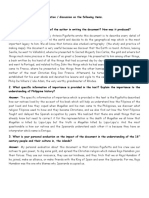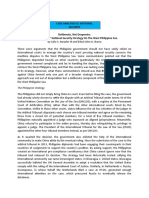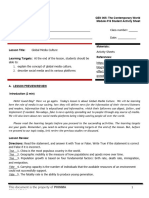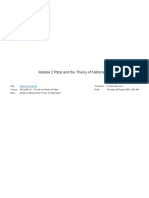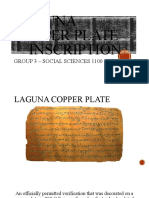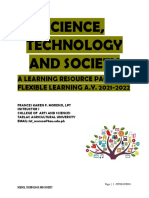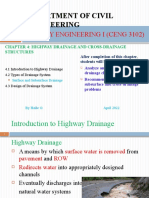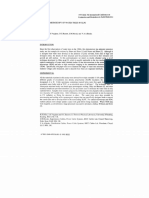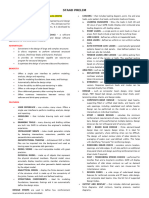Professional Documents
Culture Documents
Intellectual Revolutions
Intellectual Revolutions
Uploaded by
Lisa BangsOriginal Description:
Original Title
Copyright
Available Formats
Share this document
Did you find this document useful?
Is this content inappropriate?
Report this DocumentCopyright:
Available Formats
Intellectual Revolutions
Intellectual Revolutions
Uploaded by
Lisa BangsCopyright:
Available Formats
RIZAL TECHNOLOGICAL UNIVERSITY
RIZA
Cities of LMandaluyong
TECHNO LO
and GICAL UNIVERSITY
Pasig
Cities of Mandaluyong and Pasig
LESSON 3:
INTELLECTUAL REVOLUTIONS
Student Name
Section
Schedule
Program
College
Professor
Module Duration
GE07 – Science, Technology, and Society
1ST SEMESTER I 2021 - 2022
0
RIZAL TECHNOLOGICAL UNIVERSITY
Cities of Mandaluyong and Pasig
Intellectual
Revolutions
Learning Outcomes
At the end of this lesson, the students should be able to:
1. Identify the intellectual revolutions that shaped society’s perception of science
and technology across time;
2. Discuss how intellectual revolutions changed the way modern science was
understood and
Approached; and
3. Explain the importance of other intellectual revolutions that also took place in
other parts of the world, such as Meso America, Asia, Middle East, and Africa.
Topic Presentation
INTRODUCTION/OVERVIEW
This module analyses the intellectual revolutions that changed the way people
perceive the influence of science and technology on society in general. It gives
emphasis on three of the most important intellectual revolutions in history: Copernican,
Darwinian, and Freudian. Moreover, the module focuses also on the intellectual
revolutions that took place in many parts of the world, such as North America, Asia,
Middle East, and Asia. By discussing these intellectual revolutions in the framework of
science, technology, and society, the students are drawn to understand its relevance
to the development of modern science. This section also engages student in a critical
analysis of the current intellectual and scientific revolutions, which they may find
themselves to be part of.
Contents
Content 1 Three of the most important intellectual revolutions in history
Copernican Revolution
The Copernican Revolution discusses the
th
16 - century paradigm shift named after the Polish
mathematician and astronomer, Nicolaus
Copernicus. Nicolas Copernicus developed the
heliocentric model of the universe, meaning sun-
centered. At that time, the Earth was believed to be
the center of the universe based on geocentric
GE07 – Science, Technology, and Society 1
RIZAL TECHNOLOGICAL UNIVERSITY
Cities of Mandaluyong and Pasig
model of Ptolemy, Ptolemaic model. The idea that the Sun is the center of the universe
instead of the Earth agitated many of the scientists.
In the years that follows, similar to the Ptolemaic model, the Heliocentric model
had been found to have shortcomings also. Nonetheless, regardless with the problems
of the model, many scientists, specially Galileo Galilei, supported and accepted the
model. The Copernican Revolution ultimately caught on among other astronomers who
further polished the model and finally paved way for the birth of a new science, modern
astronomy. In the next century that follows, Sir Isaac Newton recognized the model
and this made a turning point in the study of cosmology and astronomy.
COPERNICAN
REVOLUTION.pptx
Chapters 5-7 of Thomas S. Kuhn’s The Copernican Revolution and accomplish the
Metacognitive Reading Report.
https://www.theochem.ru.nl/~pwormer/Knowino/knowino.org/wiki/Copernican_revoluti
on_(book).html
https://www.google.com/search?q=copernican+revolution&source=lnms&tbm=isch&s
a
Darwinian Revolution
The English naturalist, geologist, and
biologist, Charles Darwin is recognized for
inspiring another important intellectual
revolution in the mid-19th century. His literary
paper regarding science of evolution, On the
Origin of Species, which was published in
1859 had stirred a revolution that brought
society to a new phase of intellectual
innovation .
The Darwinian Revolution profited
from the earlier intellectual revolutions specially during the 16th and 17th century, such
that it was directed with the assurance brought about the human’s capacity to
rationalize and explain various phenomena. Darwin collected evidences pointing to
what is know as natural selection, an evolutionary process by which organisms,
including humans, inherit, develop and adapt traits that favored survival and
reproduction.
https://www.youtube.com/watch?v=JjLOvrx0_o4
https://www.google.com/search?q=+Darwinian+Revolution&tbm=isch
GE07 – Science, Technology, and Society 2
RIZAL TECHNOLOGICAL UNIVERSITY
Cities of Mandaluyong and Pasig
Freudian Revolution
The Austrian neurologist, Sigmund Freud,
is recognized for stirring a 20th-century intellectual
revolution named after him the Freudian
Revolution. Psychoanalysis as a school of thought
in psychology is the main focus of this revolution.
Freud's revolutionary theory of psychoanalysis is
considered a "great" idea in personality. It is a
scientific method of understanding inner and
unconscious conflicts embedded within one’s
personality, spring from free associations, dreams,
and fantasies of individuals.
Freud suggested that humans are intrinsically pleasure-seeking individuals.
These beliefs brought the argument of whether psychoanalysis fit into the scientific
study of the mind and the brain. Amidst controversy, Freud’s psychoanalysis is
generally recognized for dominating psychotherapeutic practice in the early 20th
century.
https://www.youtube.com/watch?v=lT4wQ02sALE
https://www.google.com/search?q=freudian+Revolution&tbm
Content 2 How intellectual revolutions transformed the views of society about
modern science
• Influence of intellectual revolutions on science and technology
• Understanding how society is transformed by intellectual revolutions
Scientific Revolution
The scientific revolution refers to the
16th and 17th centuries paradigm shift in the
scientific thoughts. It refers to successions
of occurrences that shows evidences on the
emergence of modern science during the
early modern period. The period manifested
how the developments of chemistry,
physics, and astronomy transformed the
views of humanity on nature.
This intellectual revolution is associated with the contributions made by the
following scientists in the field of astronomy, such as Galileo Galilei, Johannes Kepler,
Rene Descartes, Robert Boyle, Sir Isaac Newton and many others, which in reality
created modern science. A method was discovered for the progressive acquisition of
knowledge, the famous empirical method of science. Ultimately, this revolution ended
with the idea presented by Albert Einstein on his general relativity.
GE07 – Science, Technology, and Society 3
RIZAL TECHNOLOGICAL UNIVERSITY
Cities of Mandaluyong and Pasig
https://courses.lumenlearning.com/boundless-worldhistory/chapter/the-scientific-
revolution/
Content 3 Other intellectual revolutions that advance modern science and
scientific ideas
• Intellectual Revolutions in Meso America
• Intellectual Revolutions in Asia
• Intellectual Revolutions in Middle East
• Intellectual Revolutions in Africa
Intellectual Revolutions in Other Parts of the World
Aside from the first three intellectual
revolutions and scientific revolutions just
discussed, other intellectual revolutions
occurred across history in in various parts of
the world, such as Meso America, Asia,
Middle East and Africa. These intellectual
revolutions that took place in the four
geographical locations made their own
contribution in the advancement of modern
science and scientific thoughts.
Development of
Modern Science in Mesoamerica, Asia, Middle East and Africa.pptx
Discussion / Forum
In the study of the history of science and technology, one of the most important
areas of interest involves the various intellectual revolutions across time. In this
aspect, focus lies in how intellectual revolutions emerged as a result of the interaction
of science, technology, and society. It covers how intellectual revolutions altered the
way modern science was understood and approached.
For this discussion, intellectual revolutions in science and technology refers to
the series of events that led to the development of modern science and the progress
of scientific thinking in various periods of our history. Although there are many
intellectual revolutions, this topic focuses on the three of the most important ones that
changed the perspectives of society on how they view science: Copernican,
Darwinian, and Freudian. Moreover, other intellectual revolutions from other parts of
the world are discussed: Meso America, Middle East, Asia and Africa. In
understanding intellectual revolutions, it is worth noting that these revolutions are
paradigm shifts in the history of science and technology development.
It is common knowledge that at present we are facing global health crisis, the
Covid-19 pandemic. Science and technology innovation has helped society in
GE07 – Science, Technology, and Society 4
RIZAL TECHNOLOGICAL UNIVERSITY
Cities of Mandaluyong and Pasig
addressing this problem. We can see throughout history how technological
advancements in the modern science evolve from intellectual and scientific
revolutions that shape the society.
To understand intellectual revolutions in the context of science, technology,
and society, the following problems are posed: (a) How does intellectual revolutions
shaped science, technology, and society? (b) Cite instances in the present situation
how these revolutions advance modern science and scientific thinking.
Activities/Assignment
LEARNING TASKS
Activity 1. Group Activity
Instructions. Divide the class into six groups. Two groups will randomly pick one of the
three revolutions discussed in this section. Given sufficient time, the groups should
prepare a five-to seven – minute freestyle group presentation that demonstrates their
understanding of the intellectual revolution they picked. The students will use the rubric
below in preparing for the freestyle presentation.
Rubric for the Freestyle Group Presentation
On the Scientific Revolutions
Criteria Indicators %
1. Knowledge if the a. How well does the group understand 50
scientific revolution the intellectual revolutions and its key
concepts?
b. How well does the presentation
reflect this understanding?
2. Creativity a. How is the group able to inject 30
creativity and innovation in their
presentation?
b. How well does the mode of
presentation entertain and entice the
audience
3. Teamwork a. How well does the group work as a 20
team as evidenced by the distribution
of task and actual participation during
the presentation?
Activity 2. Metacognitive Reading Report (Assignment)
Following the same intellectual revolution assigned to your group during the previous
activity, read Chapters 5-7 of Thomas S. Kuhn’s The Copernican Revolution and
accomplish the Metacognitive Reading Report.
https://www.theochem.ru.nl/~pwormer/Knowino/knowino.org/wiki/Copernican_revoluti
on_(book).html
GE07 – Science, Technology, and Society 5
RIZAL TECHNOLOGICAL UNIVERSITY
Cities of Mandaluyong and Pasig
1. Difficult Concepts
a. ___________________________________________________________
________________
b. ___________________________________________________________
________________
2. Learning Insights
a. Before reading the article, I thought that
___________________________________________________________
________________
However, after reading the article, I learned that
___________________________________________________________
________________
b. Before reading the article, I thought that
___________________________________________________________
________________
However, after reading the article, I learned that
___________________________________________________________
________________
3. Discussion Questions
a. ___________________________________________________________
________________
b. ___________________________________________________________
________________
Activity 3. Reading Enrichment -Pair Work (Diad)
Individual Activity Instructions: Aside from the three intellectual revolutions
discussed in this section, other intellectual revolutions also took place across history
in many parts of the world, such as in North America, Asia, Middle East, and Africa.
Research on a particular intellectual revolution that took place in any of the four
geographical locations mentioned. Submit a four-slide Powerpoint Presentation and
describe the highlights of your chosen intellectual revolution. Use the following guide
questions for your presentation.
1. What is the intellectual revolution all about? (Answer in 2 lines)
2. Who are the key figures in the revolution? (Answer in 2 lines)
3. How did the revolution advance modern science and scientific thinking at the
time?
(Answer in 4 lines)
SELF-CHECK
Choose the letter of the correct answer.
An intellectual revolution emerges as a result of the interaction of man and society.
A) True
B) False
ANSWER: A
GE07 – Science, Technology, and Society 6
RIZAL TECHNOLOGICAL UNIVERSITY
Cities of Mandaluyong and Pasig
Intellectual revolutions are necessary in understanding how society is transformed by
science and technology.
A) True
B) False
ANSWER: A
Intellectual revolutions are often met with huge support and general acceptance.
A) True
B) False
ANSWER: B
Intellectual revolutions shape science and technology and often spare society from its
influence.
A) True
B) False
ANSWER: B
The Copernican Revolution introduced the concept of heliocentricism
A) True
B) False
ANSWER: A
According to Copernicus, the Earth is at the center of the solar system.
A) True
B) False
ANSWER: B
The Darwinian Revolution change the way of people understood nature and evolution.
A) True
B) False
ANSWER: A
Charles Darwin received huge support from the church.
A) True
B) False
ANSWER: B
Sigmund Freud introduced scientific approaches to understanding the human
subconscious.
A) True
B) False
ANSWER: A
The Freudian Revolution was, in itself, controversial and met with resistance.
A) True
B) False
ANSWER: A
References
GE07 – Science, Technology, and Society 7
RIZAL TECHNOLOGICAL UNIVERSITY
Cities of Mandaluyong and Pasig
• Aldea K., Caronan H., Candido M. (2018) Science, Technology, and
Society(OBE Ready). Mnadaluyong City: Books Atbp, Publishing Corp.
• Mansarate, E. and Nieva, A. (2019) Science, Technology, and Society
(Outcome-Based Module)
• McNamara, D., Valverde, V., & Beleno, R. (2018). Science, Technology, and
Society (1st ed., pp. 1-128). Quezon City: C&E Publishing Inc.
Sample Work of Students Last Semester
GE07 – Science, Technology, and Society 8
RIZAL TECHNOLOGICAL UNIVERSITY
Cities of Mandaluyong and Pasig
GE07 – Science, Technology, and Society 9
You might also like
- The Negative and Positive of Material Economic SelfDocument2 pagesThe Negative and Positive of Material Economic SelfJUSTINE100% (1)
- Development of Science in MesoamericaDocument2 pagesDevelopment of Science in MesoamericaLouisse Angeli Abucejo100% (1)
- Field Guide To SuldanDocument250 pagesField Guide To Suldanadesso napoliNo ratings yet
- LESSON NO: 1 (3hours) Title: Learning HistoryDocument28 pagesLESSON NO: 1 (3hours) Title: Learning HistoryJeya Plays YT100% (1)
- Sas#1-Gen 005Document7 pagesSas#1-Gen 005Aldrin CamatNo ratings yet
- The Subject Is About: - Ex: Chismis May ChangeDocument3 pagesThe Subject Is About: - Ex: Chismis May ChangeDianne LabisNo ratings yet
- Reaction Paper On Never AgainDocument2 pagesReaction Paper On Never AgainJohn Wilbert R. AretanoNo ratings yet
- Activity 5 The Voyage Around The WorldDocument2 pagesActivity 5 The Voyage Around The WorldClariza PascualNo ratings yet
- Reading in Philippine HistoryDocument133 pagesReading in Philippine HistoryDaisy CantilloNo ratings yet
- CE-1A ENSC1013 MRR3 PadillaDocument2 pagesCE-1A ENSC1013 MRR3 PadillaThone Carl PadillaNo ratings yet
- Abegail Chio BSHM 1B NSTP Activity 1 To 4Document11 pagesAbegail Chio BSHM 1B NSTP Activity 1 To 4Edrin Roy Cachero SyNo ratings yet
- GEN 005 Lesson 1 To 6Document2 pagesGEN 005 Lesson 1 To 61204892920% (1)
- NSTP ReviewerDocument13 pagesNSTP ReviewerKimberlee Descatamiento100% (2)
- STS First Year Second Sem 1Document11 pagesSTS First Year Second Sem 1Andrea Nicole De LeonNo ratings yet
- Sts Module 1 Lesson 1-2Document1 pageSts Module 1 Lesson 1-2Argy de Guzman100% (1)
- Oliveros, Danah A. (Beed I) Lesson 11Document2 pagesOliveros, Danah A. (Beed I) Lesson 11Alexs VillafloresNo ratings yet
- GE3 - Contemporary-World-Finals-ReviewerDocument8 pagesGE3 - Contemporary-World-Finals-ReviewerKim Klevin MarasiganNo ratings yet
- STS FinalDocument3 pagesSTS FinalFaizal Maliga100% (1)
- 5 - Waves of TechnologyDocument21 pages5 - Waves of TechnologyFlorence Lapinig100% (3)
- When Technology and Humanity Cross FinalDocument21 pagesWhen Technology and Humanity Cross FinalCire Hermogenes50% (2)
- Philosopher Assignment 2Document2 pagesPhilosopher Assignment 2api-532304340No ratings yet
- 2.module in Science Technology & SocietyDocument6 pages2.module in Science Technology & SocietyBainaot Abdul SumaelNo ratings yet
- Online Archives and Libraries On Philippine History and CultureDocument13 pagesOnline Archives and Libraries On Philippine History and Culturefrancheska ruiz0% (1)
- This Study Resource Was: Jun Zen Ralph V. Yap BSA - 2 Year Activity 8Document3 pagesThis Study Resource Was: Jun Zen Ralph V. Yap BSA - 2 Year Activity 8John Carl B. Aparicio100% (1)
- Development of Science, Technology and Society in North East AsiaDocument27 pagesDevelopment of Science, Technology and Society in North East AsiaJeraldine DejanNo ratings yet
- Chapter 1 - Scientific Revolution (STS)Document7 pagesChapter 1 - Scientific Revolution (STS)Noreen DelizoNo ratings yet
- Globalization and MediaDocument3 pagesGlobalization and MediaPrincess Fiscal CulturaNo ratings yet
- What Strategies Can You Use To Distinguish Between Fake and Factual Information On The Internet?Document4 pagesWhat Strategies Can You Use To Distinguish Between Fake and Factual Information On The Internet?Gel Andres100% (1)
- University of Rizal SystemDocument6 pagesUniversity of Rizal SystemJonaver Villanueva0% (2)
- Core Countries: World Systems TheoryDocument2 pagesCore Countries: World Systems TheoryMena100% (2)
- Science and Technology in The PhilippinesDocument42 pagesScience and Technology in The PhilippinesJoyNo ratings yet
- Activity 1 - M2 - Human FlourishingDocument3 pagesActivity 1 - M2 - Human Flourishingroy allasNo ratings yet
- Chris Jhorel Zapanta - Case Analysis 2 National SecurityDocument4 pagesChris Jhorel Zapanta - Case Analysis 2 National Securitychris jhorel zapanta100% (1)
- Sas#16-Gen 005Document10 pagesSas#16-Gen 005Ave Gale Canada100% (1)
- NSTP 1Document3 pagesNSTP 1Jocelyn Rafael Lamoste100% (2)
- Module 2 Rizal and The Theory of NationalismDocument9 pagesModule 2 Rizal and The Theory of NationalismFrenzyn MaeNo ratings yet
- Lesson 1 - Intellectual Revolutions That Define SocietyDocument16 pagesLesson 1 - Intellectual Revolutions That Define SocietyErnesto Soriano Basinga100% (1)
- Rizal Template AssignmentDocument4 pagesRizal Template AssignmentMark RojasNo ratings yet
- Module in GEC 2 Chapter 4Document62 pagesModule in GEC 2 Chapter 4Mark Kevin JavierNo ratings yet
- Lesson 3-Gec 3 Contemporary WorldDocument6 pagesLesson 3-Gec 3 Contemporary WorldCalacja 2 Hamtic AntiqueNo ratings yet
- CH 2 STS World HistoryDocument14 pagesCH 2 STS World HistoryCogie PeraltaNo ratings yet
- Martin Heidegger's The Question Concerning TechnologyDocument2 pagesMartin Heidegger's The Question Concerning TechnologyconiNo ratings yet
- Section 4Document2 pagesSection 4Maan GasmenNo ratings yet
- Insights On R.A 1425Document1 pageInsights On R.A 1425Krista FloresNo ratings yet
- Art 002, Sas 20Document3 pagesArt 002, Sas 20vistro angelineNo ratings yet
- The Relevance of The Katipunan in The Struggle For Philippine Democracy TodayDocument17 pagesThe Relevance of The Katipunan in The Struggle For Philippine Democracy Todaysir_vic2013No ratings yet
- The Ideology of SubmissionDocument1 pageThe Ideology of SubmissionVeridica El EdgieNo ratings yet
- The Contemporary World: Quarter 1: Week 1Document20 pagesThe Contemporary World: Quarter 1: Week 1Kiermorales100% (1)
- Laguna Copper Plate Inscription: Group 3 - Social Sciences 1100Document11 pagesLaguna Copper Plate Inscription: Group 3 - Social Sciences 1100Maestro LazaroNo ratings yet
- Global Media CulturesDocument2 pagesGlobal Media Cultureskimiku saylonNo ratings yet
- STS Compiled FinalDocument40 pagesSTS Compiled FinalAsi Cas JavNo ratings yet
- STS - Facebook Data PrivacyDocument2 pagesSTS - Facebook Data PrivacyElla Nicolas0% (1)
- Mandaya and Dagmay Weaving at Kadayawan 2012Document8 pagesMandaya and Dagmay Weaving at Kadayawan 2012Erica Bulaquiña Guiñares100% (1)
- Family Tree of RizalDocument2 pagesFamily Tree of RizalAngelly V VelascoNo ratings yet
- Science, Technology, and SocietyDocument10 pagesScience, Technology, and SocietybeaNo ratings yet
- Asian Civilization African Civilization Western CivilizationDocument3 pagesAsian Civilization African Civilization Western CivilizationDiana Rose Pacelo100% (1)
- Intellectual RevolutionDocument4 pagesIntellectual RevolutionKAYELYN JOY REGALANo ratings yet
- STS Module 2Document4 pagesSTS Module 2hithisisklNo ratings yet
- Intellectual RevolutionsDocument24 pagesIntellectual RevolutionsMAERYL SHANE VIAÑANo ratings yet
- Lecture 3Document6 pagesLecture 3Wency AquinoNo ratings yet
- St. Louis College of Bulanao: Science, Technology and SocietyDocument11 pagesSt. Louis College of Bulanao: Science, Technology and SocietyJonalyn Daliyong SagubanNo ratings yet
- Reviewer in Intellectual RevolutionDocument2 pagesReviewer in Intellectual RevolutionLisa BangsNo ratings yet
- Industrial RevolutionDocument11 pagesIndustrial RevolutionLisa BangsNo ratings yet
- Science and Technology in The Philippines and The EnvironmentDocument2 pagesScience and Technology in The Philippines and The EnvironmentLisa BangsNo ratings yet
- DILEMMA by Boris Paval ConenDocument1 pageDILEMMA by Boris Paval ConenLisa BangsNo ratings yet
- Ding H. Automatic Structural Synthesis - Design of Mechanisms 2022Document302 pagesDing H. Automatic Structural Synthesis - Design of Mechanisms 2022kuleyaNo ratings yet
- Thesis Abstract ExpressionismDocument4 pagesThesis Abstract Expressionismpamelacalusonewark100% (2)
- Bronze Age Tell Tell Like and Mound LikeDocument37 pagesBronze Age Tell Tell Like and Mound LikeLucian SebastianNo ratings yet
- Detailed Requirement SheetDocument53 pagesDetailed Requirement SheetRohit QualityNo ratings yet
- 25 Acres West Bay & Site PlanDocument57 pages25 Acres West Bay & Site PlanervinNo ratings yet
- University of Dhaka: Choice ID College NameDocument2 pagesUniversity of Dhaka: Choice ID College NameNI L OYNo ratings yet
- CH 4Document62 pagesCH 4Haile GuebreMariamNo ratings yet
- Guideline To Drawing StandardsDocument19 pagesGuideline To Drawing StandardsThinh DuyNo ratings yet
- AVL. Fire. Version 8. Vol 2 - Combustion. CFD Solver v8.3 - CombustionDocument99 pagesAVL. Fire. Version 8. Vol 2 - Combustion. CFD Solver v8.3 - Combustionali fNo ratings yet
- Appendix 1 - RPPDocument26 pagesAppendix 1 - RPPnurul khairunnisaNo ratings yet
- TopSolid'Cam 2023Document2 pagesTopSolid'Cam 2023Dimitris Papaioannou100% (1)
- Coastal Eng.: University of Sharjah Dept. of Civil and Env. EnggDocument66 pagesCoastal Eng.: University of Sharjah Dept. of Civil and Env. Enggmuhammad usman HaiderNo ratings yet
- 64dca1451cf0d Ati Teas 7 Test Bank With Answer Key and Explanation PDFDocument87 pages64dca1451cf0d Ati Teas 7 Test Bank With Answer Key and Explanation PDFantony wamunyuNo ratings yet
- Powercrete R95 Application Instructions Cartridge Spray Guide April 2021 V1Document8 pagesPowercrete R95 Application Instructions Cartridge Spray Guide April 2021 V1Pammy JainNo ratings yet
- NDT Request - RT DTD 06.05.19Document81 pagesNDT Request - RT DTD 06.05.19Kushal PraviraNo ratings yet
- Regional GeographyDocument548 pagesRegional Geography3024 SHAILENDRA SHARMANo ratings yet
- The Universe and The EarthDocument13 pagesThe Universe and The Earthana trasobaNo ratings yet
- Fourthsummative Test For 2ND Quarter in 21ST Century Literature From The Philippines and The WorldDocument1 pageFourthsummative Test For 2ND Quarter in 21ST Century Literature From The Philippines and The WorldErwin CastilloNo ratings yet
- 2019 - Acton Et Al. - Putting Emergence Back in Leadership Emergence A Dynamic, Multilevel, Process-Oriented FrameworkDocument20 pages2019 - Acton Et Al. - Putting Emergence Back in Leadership Emergence A Dynamic, Multilevel, Process-Oriented FrameworkMin PuNo ratings yet
- Quantum Mechanics and PeriodicityDocument51 pagesQuantum Mechanics and Periodicitynxumalopat2No ratings yet
- Ghaleh 2017Document24 pagesGhaleh 2017AlejandroNo ratings yet
- Gottlob Frege: Jump To Navigationjump To SearchDocument22 pagesGottlob Frege: Jump To Navigationjump To SearchEugen PrintNo ratings yet
- Electron Microscopy of Water Trees in XlpeDocument5 pagesElectron Microscopy of Water Trees in XlpeNoé Rafael Colorado SósolNo ratings yet
- معدل الفشلDocument338 pagesمعدل الفشلAmer AlmansoryNo ratings yet
- PDS - Mix X520 Addmix ProtectDocument2 pagesPDS - Mix X520 Addmix Protectjasondouglas1810workNo ratings yet
- Staad Reviewer PrelimDocument6 pagesStaad Reviewer PrelimcarldomingoNo ratings yet
- Biosynthesis and Characterization of Copper Nanoparticles From TulsiDocument10 pagesBiosynthesis and Characterization of Copper Nanoparticles From TulsiRabeea NasirNo ratings yet
- 6.scope of Educational PsychologyDocument7 pages6.scope of Educational PsychologyshiranthaNo ratings yet
- Introductory Econometrics IGNOUDocument212 pagesIntroductory Econometrics IGNOUhs21d017No ratings yet







